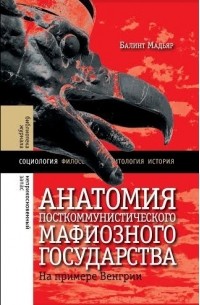
Автор
Балинт Мадьяр
Bálint Magyar
4.4
4.4
15оценок
Рейтинг автора складывается из оценок его книг. На графике показано соотношение положительных, нейтральных и негативных оценок.
| 5 | 10 | |
| 4 | 2 | |
| 3 | 3 | |
| 2 | 0 | |
| 1 | 0 | |
| без оценки |
8 |
15оценок
Лучшие книги Балинта Мадьяра
По популярности
-
 Балинт Мадьяр
Анатомия посткоммунистическ...
Балинт Мадьяр
Анатомия посткоммунистическ...
ISBN: 978-5-4448-0564-0 Год издания: 2016 Издательство: Новое литературное обозрение Язык: Русский Аннотация
РазвернутьЧто представляет собой современная посткоммунистическая Венгрия, одно из государств Центральной Европы, входивших в так называемый социалистический блок и обремененных печальным наследием тоталитаризма? Какие общественно-политические метаморфозы пришлось претерпеть ее системе, как можно охарактеризовать сформировавшийся в стране режим и чем он отличается от режимов…
-
 Балинт Мадьяр, Балинт Мадлович
Посткоммунистические режимы...
Балинт Мадьяр, Балинт Мадлович
Посткоммунистические режимы...
ISBN: 978-5-4448-1737-7 Год издания: 2022 Издательство: Новое литературное обозрение Язык: Русский Аннотация
РазвернутьПосле распада Советского Союза страны бывшего социалистического лагеря вступили в новую историческую эпоху. Эйфория от краха тоталитарных режимов побудила исследователей 1990-х годов описывать будущую траекторию развития этих стран в терминах либеральной демократии, но вскоре выяснилось, что политическая реальность не оправдала всеобщих надежд на ускоренную…
-
 Балинт Мадьяр, Балинт Мадлович
Посткоммунистические режимы...
Балинт Мадьяр, Балинт Мадлович
Посткоммунистические режимы...
ISBN: 978-5-4448-1738-4 Год издания: 2022 Издательство: Новое литературное обозрение -
 Балинт Мадьяр, Bálint Madlovics
The Anatomy of Post-Communi...
Балинт Мадьяр, Bálint Madlovics
The Anatomy of Post-Communi...
ISBN: 9789633863701 Год издания: 2020 Издательство: Central European University Press Аннотация
Offering a single, coherent framework of the political, economic, and social phenomena that characterize post-communist regimes, this is the most comprehensive work on the subject to date. Focusing on Central Europe, the post-Soviet countries and China, the study provides a systematic mapping of possible post-communist trajectories.
At exploring the structural foundations of post-communist regime development, the work discusses the types of state, with an emphasis on informality and patronalism; the variety of actors in the political, economic, and communal spheres; the ways autocrats neutralize media, elections, etc. The analysis embraces the color revolutions of civil resistance (as in Georgia and in Ukraine) and the defensive mechanisms of democracy and autocracy; the evolution of corruption and the workings of “relational economy”; an analysis of China as “market-exploiting dictatorship”; the sociology of “clientage society”; and the instrumental use of ideology, with an emphasis on populism. Beyond a cataloguing of phenomena—actors, institutions, and dynamics of post-communist democracies, autocracies, and dictatorships—Magyar and Madlovics also conceptualize everything as building blocks to a larger, coherent structure: a new language for post-communist regimes.
While being the most definitive book on the topic, the book is nevertheless written in an accessible style suitable for both beginners who wish to understand the logic of post-communism and scholars who are interested in original contributions to comparative regime theory. The book is equipped with QR codes that link to www.postcommunistregimes.com, which contains interactive, 3D supplementary material for teaching.